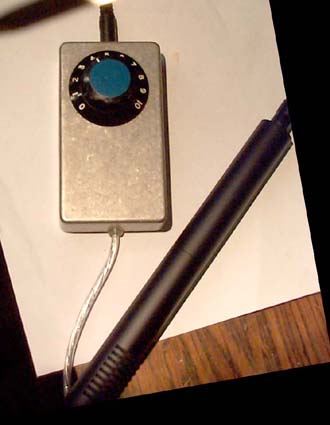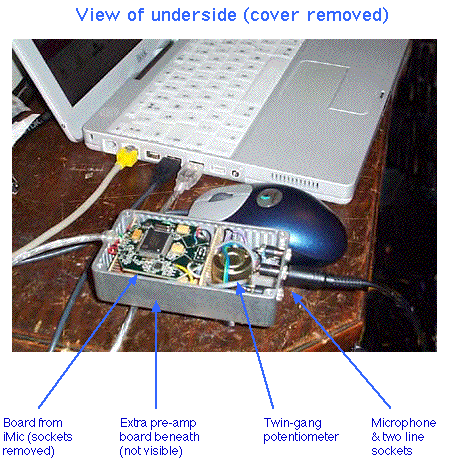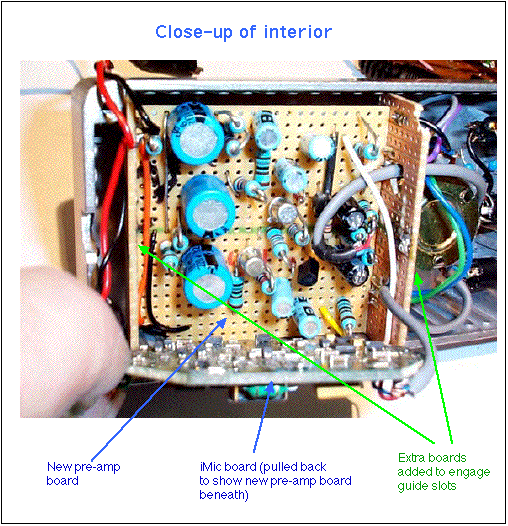|
CONVERTING A
GRIFFIN iMIC
|
THE ORIGINAL PROBLEM
as posted on uk.comp.sys.mac
|
I have been asked by the owner of a white iBook to to
help set it up for portable stereo interview recording.
(This was the one I previously mentioned suffered copious
amounts of hum when used with the power supply plugged in.)
The input device is an 'iMic' adaptor which converts audio
to USB
We became a little suspicious of the design quality of
the iMic when we found that you had to switch the input
attenuator to 'Mic' for line inputs and to 'Headphone' for
mic inputs - but we persevered.
With a semi-pro quality electret microphone which
delivered a sensible signal level, I had to keep the
on-scren gain controls of 'Coaster' right at maximum to get
a reasonable input reading. Under those conditions, the
signal to noise (mainly hiss) ratio was 35 dB - that's
similar to a 78 and considerably worse than a pre-war AM
radio.
Unplugging the mic caused the hiss level to rise slightly
and the iMic became microphonic, producing 'boings' and
'clunks' if you tapped it. When you handled it, the hum
level rose, even though everything was running on batteries.
I tried pre-amplifying the mic to about -13 dBm and, with
the 'Coaster' controls turned down, achieved a S/N ratio of
better than 60dB - perfectly respectable for the job in
hand. The noise was obviously in the iMic, not in the
microphone.
In desperation, I dismantled the iMic and discovered
that, from the audio point of view, it's design and
construction is utterly appalling. Neither the mic socket
not any of the input wiring is even screened, the silvery
appearance of the casing is just non-conductive paint. I
have seen bettter design in a 'throwaway' cassette player.
For a few pence on an item costing 60 UKP (although it is
only 35 USD) they could have put it right and produced a
good quality job. Low noise amplifiers are so cheap, I am
surprised anyone even bother to specify a different one. It
also needs a bit of bent tin screening and the switch wiring
sorting out - and this is 'Revision 3' I see from the board
markings!
Heaven help us, what are Apple playing at, condoning
junk like this!
|
THE SOLUTION TO THE
PROBLEM
|

|
A box containing the circuit board
from the iMic with an additional pre-amp and volume control
This was designed to allow the Griffin
iMic to be used with a microphone input and to achieve a
reasonable level of quality. The chip used in the this
device for converting audio to USB signals is the Philips
UDA1325 which has the capability of 24-bit conversion, far
higher quality than the 30dB signal to noise ratio measured
from the iMic on its high gain setting.
The iMic also had no blocking capacitors
to prevent the input bias of the microphone pre-amp from
being short-circuited by a D.C. path through the microphone.
As a consequence, it would not operate with many types of
good quality microphone.
|
To overcome the shortcomings of the original device, a pre-amplifier
was needed which would raise microphone signals to a level where the
iMic could be used at its lower gain setting to give a better signal
to noise ratio.
In addition, the necessary D.C. blocking
capacitors could be added and the whole equipment mounted in a
screened enclosure to reduce pickup of electrostatic noise.
A large volume control knob was also incorporated
to allow for easy adjustment of input levels during 'live'
recordings
The original intention was to use the volume
control to vary the gain of the pre-amp, thus providing sufficient
gain to cope with low input signals but avoiding overloading with
larger signals. To achieve this with a sensible relationship between
knob position and gain would have required either a specially
manufactured potentiometer or extra circuitry, for which there was
insufficient space. Eventually a normal potentiometer circuit was
used with fixed amplifier gain of about 30dB . This was found to give
a sensible compromise between gain and overload over the range signal
levels from a domestic-quality electret microphone in the sort of
'interview' situations this unit was intended for recording.

The diagram shows one channel, the second channel
is identical. R12 and C6 are common to both channels.
Two 'Line' sockets were provided, connected in
parallel. This is to allow a pair of headphones or powered
loudspeakers to be used to monitor the sound from the tape recorder
or other input device in cases where the Mac does not allow
monitoring during the recording process.
The value of R8 sets the gain of the stage, in the
event of other values of gain being found necessary, R8 can be
altered as follows:
|
Gain (dB)
|
10
|
20
|
30
|
40
|
|
R8 (ohms)
|
56k
|
15k
|
390
|
82
|

The microphone and headphone sockets were removed
from the iMic board to reduce its overall height. Connecting wires
being soldered to the vacant solder pads.
Two small pieces of board were cut and soldered to
the main board to support it in the vertical guide slots of the box.
One end of the iMic board was then supported by a short piece of
stiff wire soldered from its earth plane to earthed tracks on one of
the vertical boards. The other vertical board was cut down to support
the opposite end of the iMic board which overhung it. When the lid of
the box is in place, this arrangement allows very little unwanted
movement of the boards.
A sheet of Mylar film was glued to the inside of
the box lid and another was interposed between the pre-amp board and
the iMic board to prevent short circuits. The space available was
very restricted and considerable difficulty was encountered in
getting all the components into the box without damage.

Veroboard was used for the construction of the
pre-amp. It had to be checked at every stage of the construction
process as it is particularly prone to short-circuits between tracks
- if multiple faults had been allowed to accumulate, they might have
proven almost impossible to locate and eliminate when construction
was complete.
This is not recommended as a project for
the inexperienced constructor - the above notes are offered for
interest only and the reader takes full responsibility for any action
based upon them.
See also:http://www.poppyrecords.co.uk/other/mics.htm


